Can we – do we – see ourselves as designers of learning experiences?
Today’s session offers T³ International Conference participants an opportunity to go deep. Friday’s sessions ran for either 60 or 90 minutes. While there are 60 and 90 minute sessions at the conference today, participants may also elect to spend four or six hours in learn-by-doing sessions.
Here’s what we submitted for the program:
Design for Learning and Inquiry
Interested in more inquiry from student-learners? In this hands-on session we will focus on designing one-page TI-Nspire documents that promote investigation, learning, and inquiry. Our goal is to learn by doing. We want participants to be able to say at the end of this session: 1) I can exercise the ideas of simplicity and restraint when designing TI-Nspire learning investigations; 2) I can storyboard a learning investigation prior to beginning to design to streamline the concept and balance the information to be learned; and 3) I can create TI-Nspire documents to promote learning and inquiry. Bring your laptop with TI-Nspire Teacher Edition and sample learning targets or assessments that you will tinker with.
Here’s how it was printed in the program.
We want our participants to learn to design a one-page TI-Nspire document that promotes student investigation, learning, and inquiry. Our goal is to discuss – experientially – the essential learnings for the summer workshop. We know we can’t do justice to a 2-day workshop in 2 hours. We planned to go deep into one activity rather than cover the entire agenda at a rapid pace.
We encourage the idea of Storyboarding prior to launching in to designing with TI-Nspire. We are inspired by Garr Reynolds and Presentation Zen. In particular we are going to try to avoid creating Nspire documents that are slideuments. For more information, please read “Slideuments” and the catch-22 for conference speakers.
Our hope: At the end of this workshop, participants should be able to say:
- I can exercise the ideas of restraint and simplicity when designing learning investigations.
- I can identify what is important and remove what is not important.
- I can design where less is more visually – I can include only what is necessary to promote inquiry and investigation.
- I can design documents that are engaging and prompt questions and inquiry from the learner.
- I can storyboard a learning investigation prior to beginning to design to streamline the concept and balance the information to be learned.
- I can explain the goal of the activity and outline the expected learning outcomes.
- I can design a variety of dynamic constructions that are controlled by different inputs including points, sliders, and stored variables.
- I can design documents with a variety of outputs, which use color and strings to support opportunities for visual connections.
- I can create TI-Nspire documents to promote student investigation and inquiry.
- I can enhance documents with conditional statements to make information appear and disappear as needed to enhance a lesson.
- I can apply TI-Nspire construction tools: geometry tools, scatterplots, data capture, etc. to create the investigation.
- I can use free points, restricted points, sliders, stored variables, etc. to control the actions in the document.
- I can use color, text boxes, strings, etc. as inputs and outputs to connect ideas and promote questions.
We have a plan which is shared below, but we are going to lead our learners by following their questions.
Essential learning: I can explain the effects of a, h, and k in the vertex form of a parabola.
Level 1: I can graph a parabola and use the interactive tools of TI-Nspire to shift and stretch the parent function to investigate graphs of parabolas.
Feedback:
- I like that learners can shift and stretch the graph to see the graph and function change.
- I wonder if the decimals are helpful or distracting.
- What if we created a document where the values of h and k are Integers?
Level 2: I can design a document to stretch and shift a parabola where the values of h and k are Integers.
Feedback:
- I like that the values of h and k are restricted to Integer values. I like that I can control the step of these values by changing the scale of the graph.
- I wonder if learners will connect the values of (h, k) shown in the ordered pair to the equation.
- What if the equation showed the numerical values of h and k rather than the symbols?
Stage 3: I can design a document to stretch and shift a parabola where the values of h and k are Integers and the function dynamically shows the numerical values of h and k as the function changes.
Here’s what we planned to do:
 Here’s what our participants prompted us to actually do because of the question How might we use color?:
Here’s what our participants prompted us to actually do because of the question How might we use color?:
Stage 4: I can design a document to stretch and shift a parabola where the function dynamically shows the numerical values of a, h, and k as the function changes.
Final Nspire document shown above
We’ve left the last hour for application and coaching. Participants are invited to create their own document. We are available for trouble-shooting and brainstorming.
Here’s the next challenge for curious learners:
Final Nspire document shown above.

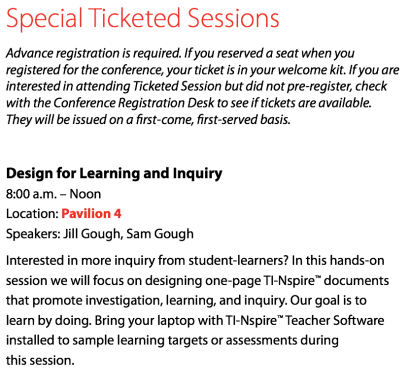
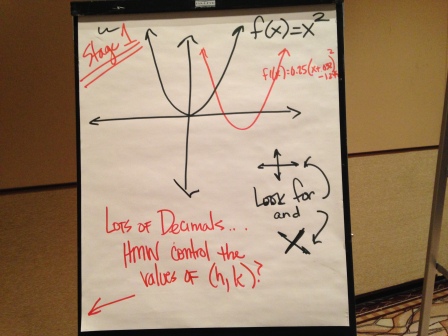


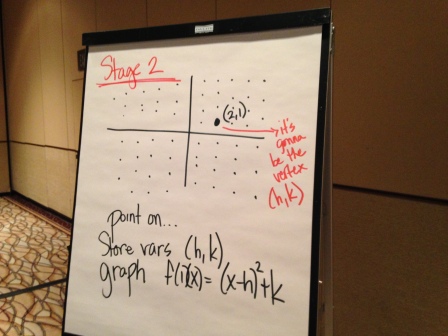


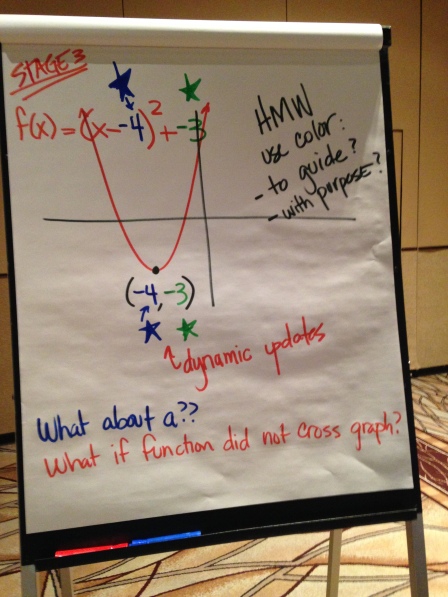




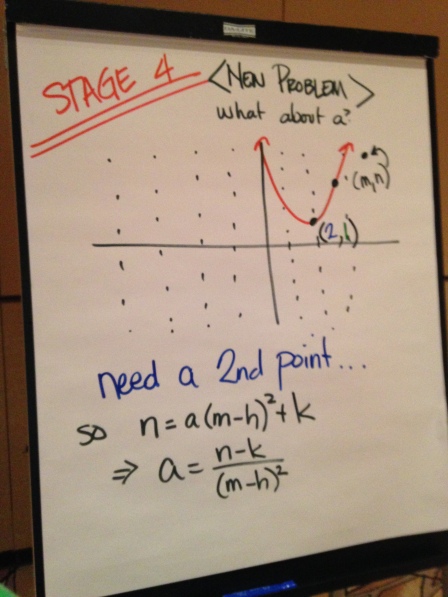




I have no experience, and little understanding of TI-Nspire (and only slightly more experience and understanding of math), but I appreciate the Storyboarding and Presentation Zen links here, Jill. Sounds like it would be a worthwhile session for those that attended. I wonder how some of these ideas might translate to what I do with my reading classes. Where should I incorporate more simplicity? Where should I use more restraint? Have you used a similar approach when working with the ELA/Humanities teachers at Trinity? If so, I’d be interested in learning more.
LikeLike
I do have ideas on how we might incorporate simplicity and restraint into ELA. I’d love to brainstorm with you. In particular, I think these ideas can contribute to your wonderful Diving into #PBL learning experiences. Let’s find time to collaborate soon!
LikeLike